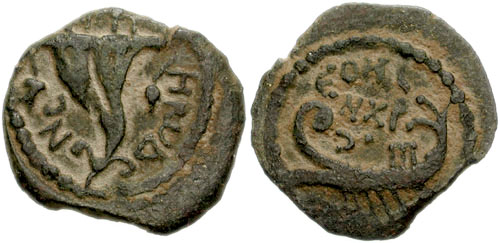03.06.07 4 B.C. – A.D. 6 Herod Archelaus Ethnarch Rules over Judea, Samaria, and Idumea[1]
To have successfully ruled over these three provinces would have required considerable administrative skill, as each province had its own distinctive people group.
- In Judea/Israel lived the Jewish people who were divided into a number of religious sects, from the Greek-loving Hellenistic Jews on the left to the orthodox and Essene Jews on the right.
- In Samaria were the Samaritans who believed only in a modified version of the five books of Moses.
- In Idumea were descendants of Esau who were forcibly converted to Judaism in the second century B.C. In later centuries they became absorbed into the Arab world.
The nineteen year old Archelaus inherited these three provinces but had none of his father’s administrative qualities. When his father passed away, the people rejoiced at the death of the tyrant and were delighted to see a new monarch come to the throne. In a public speech in the temple Archelaus wished them peace and prosperity. However, once his position was secured by Rome, his attitude change and he became far more brutal than was his father.

Coin of Herod Archelaus-Courtesy of Wikipedia Commons
At this time the hatred and conflicts between the Samaritans and Jews was well-known. But a common enemy can turn squabbling neighbors into cooperative teams. The persecution initiated by Archelaus upon both groups was so severe, that for a while the two groups set aside their hatred and bitterness for each other, and formed a delegation that went to Rome and appealed to Caesar Augustus.[2] While there, Jews revolted in Jerusalem and the Samaritans did likewise in their communities. Roman soldiers responded in Jerusalem by robbing the temple treasury and setting fire to the temple pillars.[3] When the people protested this evil act, 3,000 more were slaughtered in a single day by Herod’s son, Archelaus.[4] Because of his brutality and ongoing conflict, when Joseph returned from Egypt, he most likely took his young family along the Via Maris northward along the coast, and then inland to Nazareth.[5] Joseph avoided Bethlehem and the area ruled by the nineteen year old tyrant.
In response to the sacrilege of the temple, more Jews joined the riots and nearly every Roman garrison was attacked. By the time Archelaus returned, the Roman generals enforced Roman peace – Pax Romana.[6] The Jewish people continued to appeal to Rome for a change of leadership and a greater degree of self-rule. Rome finally agreed and in the ninth year of his reign, Archelaus was banished to Vienna in Gaul (modern France).[7] The office of “kingship” was replaced by the office of “procurator,” a Roman governor.[8]
From this experience, the procurators who reigned were wise enough to forbid Roman soldiers from entering the temple area that was restricted to only Jews. Soldiers who did so were put to death by the order of the procurator. Of all the people groups within the Roman Empire, the Jewish people were the only ones who were granted the following exemptions:
- They did not participate in Roman worship and,
- The Romans agreed not set up any images in their temple. In fact, Roman generals even agreed not to have their soldier’s units carry images of military eagles throughout Jewish territory.[9]
In spite of the cruelties of Rome, these two concessions show that the Romans were willing to compromise with their subjects in order to maintain peace.
[1]. Since ancient writers, as well as other writers throughout history, have used the terms “Judaea,” “Judea,” “Judah,” and “Israel,” interchangeably, see “Judaea” in Appendix 26.
[2]. Finegan, Chronology. 300; Josephus, Antiquities. 17.9.6; Edersheim, The Life and Times of Jesus the Messiah. 163.
[3]. Golub, In the Days. 268.
[4]. Keller W. The Bible as History. 371.
[5]. See map 04.05.02.Z depicting the most likely route of travel for the Holy Family.
[6]. Lee, The Galilean Jewishness of Jesus. 72-73; Mellowes and Cran, Executive Producers. From Jesus to Christ: The First Christians. (DVD). Part 1; See “Pax Romana” in Appendix 26.
[7]. From 4 B.C. to A.D. 6 is nine years, not ten, because there is no year “zero.”
[8]. Golub, In the Days. 268.
[9]. Golub, In the Days. 270-71.